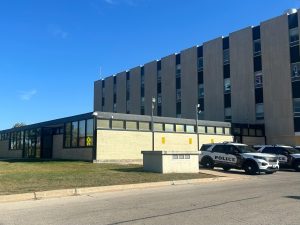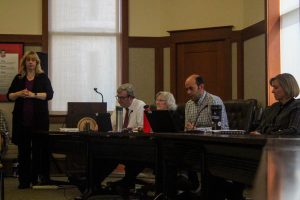Coffeehouse opens
October 19, 1989
It’s good for the heart, and the soul.
After years of discussion, a motivated group of DeKalb residents have made the DeKalb “Coffeehouse” a reality. There is no official name thusfar, because the proprietor, Curt Halsted, wants one to evolve from its patrons.
Coffeehouses are premised on the idea of communication. It is a place where one can sit and talk for hours “and not feel hassled by someone handing you a check,” said Halsted.
Coffeehouses were popular in the 40’s and 60’s. They seem to come around every twenty years as people renew their awareness of their environment, and other societal issues.
If motivaton is the key to success, the Coffeehouse should be a motherlode. All of its workers take pride in their work and take its success personally. It’s something they all wanted for a long time. However, it took Halsted to get the ball rolling.
Halsted took his idea to the Greater DeKalb Partnership where they helped him draw up a business proposal. With their help, a local bank in DeKalb granted Halsted a loan.
Sue Kuemmeth, a runner/counterperson, says she is personally “amazed” by Halsted’s achievement. She said that until now, a coffeehouse in DeKalb was just an idea.
Kuemmeth said she hopes the Coffeehouse will attract a “dual” crowd. In addition to the regulars, Kuemmeth hopes the curious also will stop in. Currently, Kuemmeth is one of about fifteen workers at the Coffeehouse.
Halsted said he perceives no problem in finding help for the Coffeehouse because there are many people who want to see it succeed. He said there “have been a great number of people who have wanted a coffeehouse but, for whatever reason, haven’t been able to pull it off.”
“About seven years ago, there was a coffeehouse across the street,” said Halsted, who believes the past coffeehouse failed due to mismanagement. Halsted’s Coffeehouse is located at 131 E. Lincoln Hwy., in downtown DeKalb. Their number is 756-6663. They haven’t planned on preparing carryouts, but something can be arranged if necessary.
Music is central to the Coffeehouse. Open mike night, a mainstay of coffeehouses, is Thursday. However, musicians are welcome most anytime. Halsted would like the Coffeehouse to be a catalyst for local bands.
Also important to the Coffeehouse is art. Patrons are encouraged to bring in their art to be displayed on the walls. There is nothing concretely planned as of yet, but Halsted said he would like to construct a piece of performance art where people could take a part of it home with them, then, return it completed.
Back in the days of Jack Kerouac and Allen Ginsberg, at the inception of coffeehouses, poetry readings and political discussions were popular. Halsted plans to have speakers in the future, but none have been planned yet.
Kuemmeth said no one has read their poetry since the Coffeehouse opened Oct. 11, but added that she has “no doubt that it will happen.” Once someone gets the nerve, lots of people will be up there (on stage), she said.
The most important aspect of the Coffeehouse is its food. All food is prepared on-site; and all food is made naturally. There are no additives or preservatives in the menu. And each item is checked by nutritionist Arlene Bland, so food is suitable for heart patients. Bland also prepares muffins and other baked goods at the Coffeehouse. Halsted said Bland will be starting a business of her own shortly. She will be working out of the Coffeehouse until she gets an establishment of her own. She will remain a consultant to the Coffeehouse, Halsted said.
The cook is Scott Cole, who Halsted considers a partner and co-manager. Cole spent plenty of time working for area restaurants before working with Halsted at the Coffeehouse.
Halsted said the Coffeehouse is the perfect working environment for Cole, because he is encouraged to be creative with the menu. Cole had problems with past employers because of his need to be creative with their menus, Halsted said.
All employees contribute to the menu with recipes if they wish. Halsted welcomes employee input, and seems receptive of ideas from patrons also.
Keeping with the heart-smart idea, the menu carries only two types of meat—turkey and chicken. The menu is loaded with vegetables which are fresh and organic. All breads are made at the Coffeehouse also.
Drinks include juices, mineral water, natural sodas and several coffees. There’s a single cup of regular coffee for 70 cents, or a bottomless cup for $1.00. There is also specialty coffee, Cappucino, Espresso and tea.
The difference between having a cup of coffee at the Coffeehouse, and having one at a restuarant, is atmosphere. It is relaxed and patrons are encouraged to spend time there and communicate. Halsted feels students don’t know enough about important issues in the world, and that the Coffeehouse could help them becaome aware of many.
So kick back, grab some coffee, and talk about something which really matters for a change—like the United States’ subversive actions (instead of the World Series).






